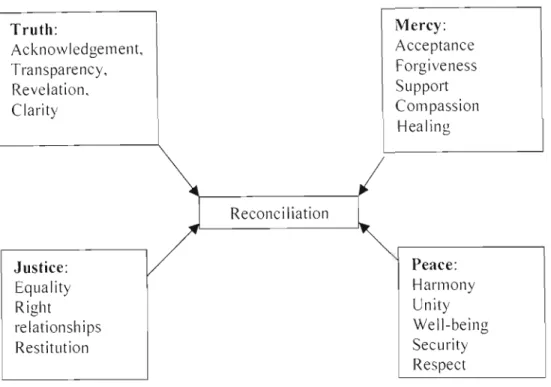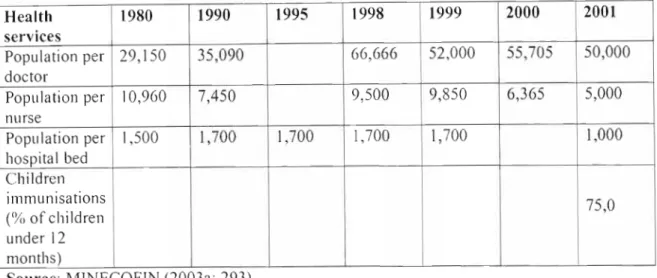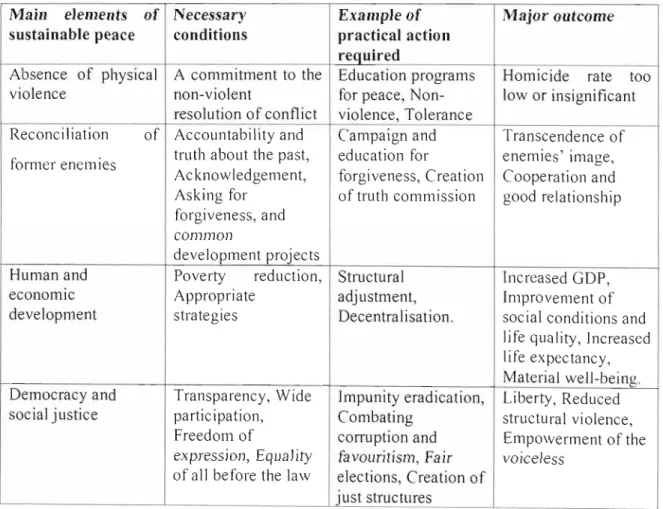This study is an assessment of the Rwandan unity and reconciliation process and was conducted to assess whether it has the potential to build lasting peace in the country. The analysis allowed a comparison of these circumstances with the context in which the unity and reconciliation process in Rwanda is taking place. NURC: Commission for National Unity and Reconciliation OPRR: Office of the President of the Republic of Rwanda PVK: Prefecture de la Vil1e de KigaJi.
The overall aim of this research paper is to study the effectiveness of the steps taken towards unity and reconciliation in post-I 994 R wanda. To explain the National Unity and Reconciliation Commission (NURC) programme, to assess its outcomes to date and to consider its potential to significantly move towards sustainable peace. A F0n11 discussion with researchers from the CCM of the National University of Rwanda will be organized on the issues of unity and reconciliation in Rwanda.
The third chapter presents the context in which unity and reconciliation are made in Rwanda after the 1994 genocide.
Chap. 2: THE CONCEPT OF SUSTAINABLE PEACE
For Pedro (1995), peace is not just the silence of the ceasefire between the army and the guerrillas. People, according to the theory of social justice, have the same opportunity as far as the law is concerned. However, it is clear even at this level that some of the mentioned conditions of sustainable peace are being met in the context of Rwanda, while others are not.
The end product was the development of ethnic hatred and poverty and the destruction of Rwanda's social fabric. The Government of Rwanda has established a number of institutions aimed at creating checks and balances, such as the National Human Rights Commission, the National Unity and Reconciliation Commission and the Office of the Auditor General of Public Finance. It has been noted that if unity and reconciliation are to be achieved in Rwanda, these root causes of conflict must be addressed.
To closely monitor whether government organizations respect and adhere to the policy of national unity and reconciliation;. In this sense, the role of the National Unity and Reconciliation Commission is essentially to provide a platform on which Rwandans can air their views on what divided them in the past, and on how to build a lasting united and reconciled Rwanda. The Commission Board consists of 12 members, and is led by a management committee consisting of the Chainnan, Vice-Chainnan and the Executive Secretary.
They meet once a month to review the program of the Pemlanent Secretariat, to monitor its functioning in achieving the objective of strengthening unity and reconciliation among Rwandans. The President of the Commission is responsible for following up and chairing Commission meetings. The programs of the National Commission for Unity and Reconciliation are grouped into three main activities: civic education, conflict mediation and support for community initiatives.
Another important policy of the national unity and reconciliation process is to promote a culture of conflict resolution through peaceful means such as dialogue and cooperation. Coordinating the action plans of government agencies and national and international non-governmental organizations aimed at improving the socio-economic status of the population in order to reduce poverty and strengthen unity and reconciliation; To incorporate the program of unity, reconciliation and patriotism into the culture of all levels of education;
To enable people of all categories to participate in the development of programs of unity and reconciliation;

C hap. 5: ASSESSING PROGRESS TOWARDS SUSTAINABLE PEACE IN RW ANDA
The main contribution of the Gacaca court system lies in its ability to reveal the truth about the genocide and other massacres that OCCllToi in Rwanda in the past years. It is therefore the responsibility of the government that inherited the chaos to create mechanisms to support the survivors of the genocide. It is plausible, given the first fruits of the process that the Gacaca process will contribute to the promotion of unity, reconciliation and peace in Rwanda.
Regarding the recent presidential and parliamentary elections in the country, the European Union Election Mission in Rwanda (EOM, 2003) says that "democratic conditions were not fully guaranteed". However, the political thinking of Rwandans continues to be influenced by the country's recent history. But the organization urges the government of Rwanda to put the theories of the new constitution into practice.
Military integration has been one of the most tangible results of the process of national unity and reconciliation. It is important to note that the security that prevails in Rwanda is the result of the relationship between former warring parties and the cooperation with the population to ensure stability and peace. All soldiers from the defeated army attended solidarity camps before being reintegrated into the army.
Education for peace produced a very special result during the infiltration movements from 1997 to 2000 in the northwest of the country. These ex-infiltrators have already established a cultural group for unity and reconciliation known as 'Abahamya b'ukuri' or 'Truth Witnesses'. ', who organize meetings to talk about the importance of unity and reconciliation in Rwanda. Education for peace, unity and reconciliation in Rwanda has become the top priority not only of the NURC but of the entire political apparatus.
NURC's Community Initiatives Support Program aims to reduce poverty while promoting unity and reconciliation. The NURC Community Initiative Support Program is part of the National Poverty Alleviation Policy. After this brief evaluation of the Rwandan unity and reconciliation process, one must ask whether the key conditions for sustainable and positive peace have been met.
The institutionalization of the Gacaca justice system, which undermines both restorative and criminal justice, will contribute to unity and reconciliation because it allows for the truth to emerge and faster results.

Chap. 6: GENERAL CONCLUSION
After the 1994 genocide, Rwandans inherited a number of consequences of the genocide, all of which were highly destructive and complex: the initially fragile economy was destroyed; The creation of traditional participatory justice known as Gacaca, which is both conciliatory and punitive. The democratization process materialized through the creation of a series of institutions aimed at promoting transparency, the participation of all, freedom and respect for human rights;
An enduring spirit and willingness to share power among Rwandans of all ethnic groups in government, arnli and police. These and other actions clearly show how decisive the political will is for uniting and reconciling Rwandans. It is obvious that the process of reconciliation in the country is taking place in a positive structural context.
This addresses the third goal - whether NURC programs and practices are aligned with the requirements for building sustainable peace. However, the process will take time to complete, just as the discriminatory ideology took a long time to tear the country apart. As Reychler and Pafenholz say, "creating a sustainable peace environment is a long and slow process because it addresses all the main components of conflicts: fixing problems that threatened the parties' core interests; changing strategic thinking; and changing the structure of opportunities and ways of interaction".
Even though the process of unity and reconciliation in Rwanda is promising, there are still factors that hinder its effectiveness. Some political leaders and intellectuals still manipulate people based on their ethical origins to achieve their political goals; Some people are reluctant to accept the Gacaca justice system and refuse to cooperate to establish the truth;
This situation suggests the need for modifications in the tools used to build lasting peace through unity and reconciliation. The inclusion of political leaders and intellectuals as participants 111 in the CIVIC education program and paying special attention to them;.
BIBLIOGRAPHY
Havugimana, A., 2001, After the genocide in Rwal/da: social and psychological cOl/sequences, Howard School of Public Health Refugee Trauma Program and National University of Rwanda, Butare. International Crisis Group, 2002, Rwanda at the end of transition: a necessary political liberalization, Brussels, Belgium and Nairobi, Kenya. Jeong, H., W., 2002, Peace and Conflict Studies: All Introduction, Institute for Conflict Analysis and Resolution, George Mason University, Ashgate, USA.
Kumar, c., 2000, Sustainable peace in war-torn societies: lessons from the Haitian experience, United Nations, New York. Office of the President of the Republic of Rwanda, OPRR, 1999, Report on the reflection meetings held in the OPRRj from May 1998 to March 1999, Kigali. Pugh, M., 2000, Regeneration in war-tom societies, Macmillan Press, London, and St Martin's Press, New York.
Verwoerd, Looking back, reaching forward: reflectiolls 011 the truth and reconciliation 0.[ Sydafrika, UCT Press, Cape Town og Zeb Press, London, 199-209. Verwoerd, Looking back, reaching forward: reflections on the truth alld reconciliation of South Africa, UCT Press, Cape Town & Zeb Press, London, 68-76. Peterson, (red.) Forgiveness and recolciliation: religion, public policy and conflict transformation, Templeton Foundation Press, Radnor PA, 27-49.
CHARGE AND NAME IMPRISONMENT HALF OF HER IS ON THE LIST SENT IN PRISON, THE OTHER IS FROM THE CELL LETTER WRITTEN IN PUBLIC WORK. HE IS PLACED ON THE LIST OF PRISONERS, THE OTHER IS BREAKED FROM THE CELL GACCA IN WORK OF PUBLIC INTEREST COURTS. 3° HE HAS NOT CONFESSED 5 TO 7 YEARS IMPRISONMENT HALF OR HALF OF HIS SENTENCE HAS BEEN PROVIDED WITH A CONFESSION HE SHOULD BE IMPRISONED THE OTHER HAS BEEN CHARGED WITH PUBLIC INTEREST WORK.
The participants promised to tell the truth under all circumstances. The teachers undertook to accompany the government and the Commission on the road.
